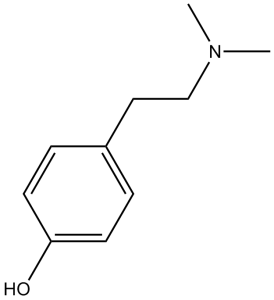This product is for research use only, not for human use. We do not sell to patients.

| Size | Price | Stock |
|---|---|---|
| 500mg | $600 | Check With Us |
| 1g | $960 | Check With Us |
| 5g | $2430 | Check With Us |
Cat #: V2019 CAS #: 539-15-1 Purity ≥ 98%
Description: Hordenine (Ordenina; Peyocactine) is a naturally occuring phenylethylamine alkaloid found in plants with antibacterial and antibiotic properties. It inhibits the uptake of norepinephrine in mammals, working as a stimulant. It is produced in nature by several varieties of plants in the family Cactaceae and by some in Acacia. Recent study shows that hordenine may be an effective inhibitor of hyperpigmentation. it inhibits melanogenesis by suppressing cAMP production, which is involved in the expression of melanogenesis-related proteins
Publications Citing InvivoChem Products
Product Promise

- Physicochemical and Storage Information
- Protocol
- Related Biological Data
- Stock Solution Preparation
- Quality Control Documentation
| Molecular Weight (MW) | 165.23 |
|---|---|
| Molecular Formula | C10H15NO |
| CAS No. | 539-15-1 |
| Storage | -20℃ for 3 years in powder formr |
| -80℃ for 2 years in solvent | |
| Solubility In Vitro | DMSO: 33 mg/mL (199.7 mM)r |
| Water: <1 mg/mLr | |
| Ethanol: 33 mg/mL (199.7 mM) | |
| SMILES Code | OC1=CC=C(CCN(C)C)C=C1 |
| Synonyms | Ordenina; Peyocactine |
| Protocol | In Vitro | In vitro activity: Hordenine (N,N-dimethyl-4-hydroxyphenylethylamine) is a phenylethylamine alkaloid with antibacterial and antibiotic properties. It inhibits the uptake of norepinephrine in mammals, working as a stimulant. It is produced in nature by several varieties of plants in the family Cactaceae and by some in Acacia. Recent study shows that hordenine may be an effective inhibitor of hyperpigmentation. it inhibits melanogenesis by suppressing cAMP production, which is involved in the expression of melanogenesis-related proteins. |
|---|
| Solvent volume to be added | Mass (the weight of a compound) | |||
|---|---|---|---|---|
| Mother liquor concentration | 1mg | 5mg | 10mg | 20mg |
| 1mM | 6.0522 mL | 30.2608 mL | 60.5217 mL | 121.0434 mL |
| 5mM | 1.2104 mL | 6.0522 mL | 12.1043 mL | 24.2087 mL |
| 10mM | 0.6052 mL | 3.0261 mL | 6.0522 mL | 12.1043 mL |
| 20mM | 0.3026 mL | 1.5130 mL | 3.0261 mL | 6.0522 mL |
This equation is commonly abbreviated as: C1 V1 = C2 V2
- (1) Please be sure that the solution is clear before the addition of next solvent. Dissolution methods like vortex, ultrasound or warming and heat may be used to aid dissolving.
- (2) Be sure to add the solvent(s) in order.




































